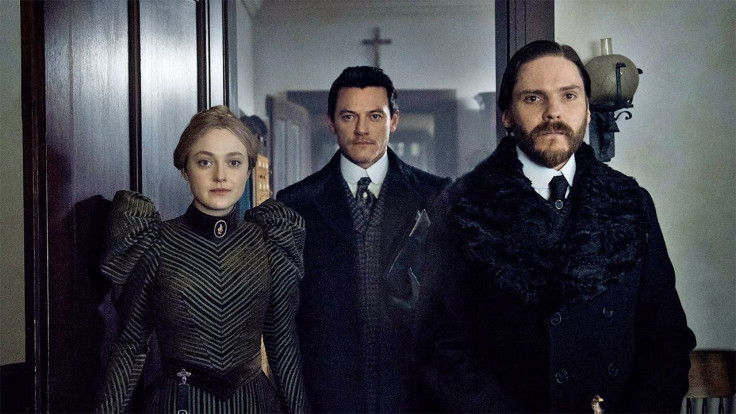The premiere of The Alienist introduced us to a serial killer stalking the underworld and the unlikely team hoping to hunt him down: an alienist (researcher into mental illness) specializing in children, a newspaper illustrator and a police secretary. Set in New York in the 1890s, The Alienist premiere captured all the seediness of the Bowery and the rise of post-Industrial Revolution structures like the stark, towering beams of elevated train tracks; the poor living in the shadow of onrushing modernity. The second episode of The Alienist, “A Fruitful Partnership,” widens the lens, revealing how the other half lives, in all their opulence and nepotistic patronage.
Much of the second episode of The Alienist takes place at the Metropolitan Opera House (torn down in 1967) and Delmonico’s steakhouse. At each location, servants nearly equal patrons, with each moment attended to with choreographed efficiency. At the opera, Dr. Kreizler ( Daniel Brühl) and John Moore (Luke Evans) negotiate the New York elite, pointing out the various powers that be, particularly Tammany Hall officials. It doesn’t do much to advance any specific plot line, but it does suggest the expansive story The Alienist is maneuvering toward, as the murders and Dr. Kreizler’s investigations intersect with every rung of society. There are obstacles ahead, most apparent when Police Commissioner Teddy Roosevelt (Brian Geraghty) rankles at Dr. Kreizler’s interruption, ruining Roosevelt’s moment with banker J.P. Morgan. We’re beginning to see that Kreizler’s apparent wealth can only insulate him so much from the bigger fish who prefer stagnant water be left undisturbed.
“A Fruitful Partnership” assembles the investigation dream team, uniting Moore, Kreizler, the forensic nerd Isaacson brothers and police secretary Sara Howard (Dakota Fanning), who uncovers hidden police files full of additional victims. But beyond that, it’s mostly an episode about the various factions that will come to define The Alienist’s serial killer investigation. We see into disgusting tenements overstuffed with Italian immigrants, socialist party meetings, brothels and private parlors. It's a theme made most pointedly when a crime boss, pimp and police sergeant assemble to discuss their own part in the cover-up, standing side-by-side in period costume as three archetypes of their era.
The investigation itself proceeds with surprising efficiency. The Isaacson brothers — themselves socially marginal Jews who underdress for Delmonico’s — track down the killer’s knife, an Arkansas Toothpick preferred by killers like “Pee Wee” Gaskins nearly a century later. And they also introduce the new science of dactyloscopy, or fingerprint identification, to the investigation.

But just as interesting as the hard science is the occasional capacity for The Alienist to draw the viewer into a genuinely different moral universe, where the definitions fail to adhere to the same categories we’d use today.
Speaking of one of the victims, Moore says, “I had the distinct impression that other boys found Georgio in some manner effete or inclined toward contrary sexual instinct.”
“Being effete and being inclined toward a contrary sexual instinct are two different things. Now, was the boy one or the other, or was he both?” Kreizler asks, evidently frustrated.
There may be a bit of Victorian prudery in Moore’s description, but the impression Moore delivers is more a struggle to find the right words. Kreizler’s frustrations are similarly due to the limitations of language. The word homosexual didn’t appear in English for the first time until 1892, just four years before The Alienist is set. Their are conceptual limitations to their entire capacity to understand the killer, because he’s targeting a category of people psychology and criminology didn’t yet understand as a category of people. Instead, they had only behavioral pathologies and atomized understandings of individual “deviances.” Even if Kreizler’s character is too tolerant and rational for his moment (earlier he kicks a priest out of his clinic for admonishing a young masturbator), he’s nevertheless thwarted by a psychology unprepared for the killer he hunts.
“A Fruitful Partnership” ends at a brothel of boys. Absent a coherent gay culture, the brothel instead simply transposes femininity on to them, dressing the young men in corsets and boas, like something out a bawdy Western. In a complete inversion of modern prejudices against trans people, the police and other men repulsed (or intrigued, but theatrically resistant) by the activity at the brothel, effortlessly adopt “she” pronouns for the boy prostitutes, preferring to mask them in a feminine identity and maintain the thin illusion of heterosexuality. It’s a shame then that “A Fruitful Partnership” ends on a silly, horror movie cliffhanger that tears apart the sophisticated portrait of Victorian sexuality, essentially monsterizing the young men of the sex trade in its final shot.
While expensive production design and costumes go a long way toward absorbing us in The Alienist ’s 1890’s milieu, it’s tiny moments, jarring discrepancies from our own cultural assumptions, that most enliven the narrative and make all those expensive sets worthwhile. It will be interesting to see how far future episodes of The Alienist can take us into the mentality of its lead characters, placing us in the same position as Dr. Kreizler as he works to see inside the mind of his serial killer.
- Beautiful costumes and sets, great atmosphere
- Powerful cast
- Great eye for historical detail
- Works along standard serial killer tropes, at least in its premiere



















